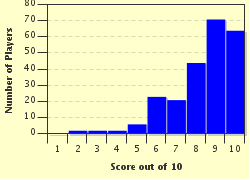Quiz Answer Key and Fun Facts
1. They are lauded as our best friends. They have been our companions the longest of all animals. Scientists now believe that this animal became domesticated over 15,000 years ago in two separate evolutionary events, one in Western Europe and one in Asia. About which of our animal helpers do they believe this?
2. Arguably our most important domesticated animal, this one has been food, transportation, standard of wealth and entertainment to us for approximately 5000 years. It made two separate journeys, widely divided by time, to the American continents. The first American incursion was over the Bering land bridge in pre-historic times. After becoming extinct some time later, Spaniards reintroduced this animal to the Americas. Prized not only for their utility but also for their beauty, what are these animals?
3. Another animal that has been domesticated twice sprang from wild stock in the Mekong Delta and from Anatolia. It is estimated that humans were raising them for food 6000 to 9000 years ago. Apart from using their bristles in a variety of brushes and their skins in footballs, and miniature versions as pets, which animal described here is almost exclusively used as food?
4. Which real life animal helped curtail a diphtheria epidemic in Nome, Alaska in 1925 by serving as the lead in a pack of sled animals that carried antitoxin to fight the disease? He has a statue in his honor in Central Park, NYC.
5. These animals, according to scientists trying to discover how they became domesticated, are actually only semi-domesticated today. They also took greater part in their own domestication, perhaps initiating contact with early human villages where they found the pests that were their prey in great abundance. Some early civilizations regarded them as gods. What are these creatures that deign to live among us?
6. Oscar, a therapy cat living in a Providence, Rhode Island nursing home is famous for an uncanny ability to do what? He has been in the news more than once for this special gift of his. What is it?
7. We have these animals in special environments in our homes, where they are valued for their calming effect on their keepers and their ease of maintenance. Owners can't really cuddle them. They don't play fetch, nor purr, nor carry things for us. Still, because we sometimes need animals that take up less space and time than dogs or cats, they are the third most sought after pets. Which animals fill this description?
8. This next animal is thought to have been domesticated about 2500 years ago. They were used for hunting rabbits in the middle ages. Today they are almost exclusively kept as pets. They do a hilarious little dance when excited, full of wiggles and leaps. They are closely related to mongooses and European polecats. They can be very affectionate, but watch those sharp little teeth. You can definitely get nipped in play and in irritation. What are these cute animals?
9. The next animal was domesticated approximately 10,000 years ago from the wild aurochs. We have used them for meat, milk and draft animals. One of their unusual traits is their ability to interbreed with quite a few related species which improves their chances of surviving evolutionary pressures. What are these placid-unless-provoked animals?
10. In 2003, a paleontologist found a 68,000,000 year old Tyrannosaurus Rex thigh bone fossil with a flexible blood vessel preserved within it. Recently, analyses of the amino acid sequences from the specimen revealed that the closest living relative of the T-Rex is what common domesticated animal?
Source: Author
hpreed62
This quiz was reviewed by FunTrivia editor
guitargoddess before going online.
Any errors found in FunTrivia content are routinely corrected through our feedback system.

